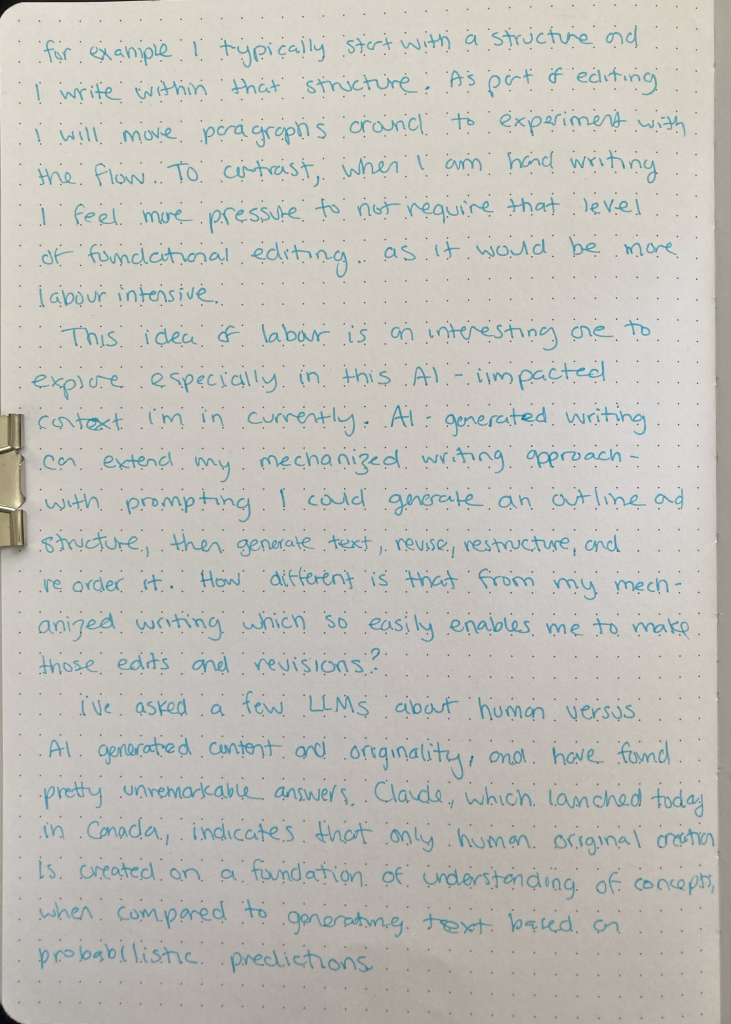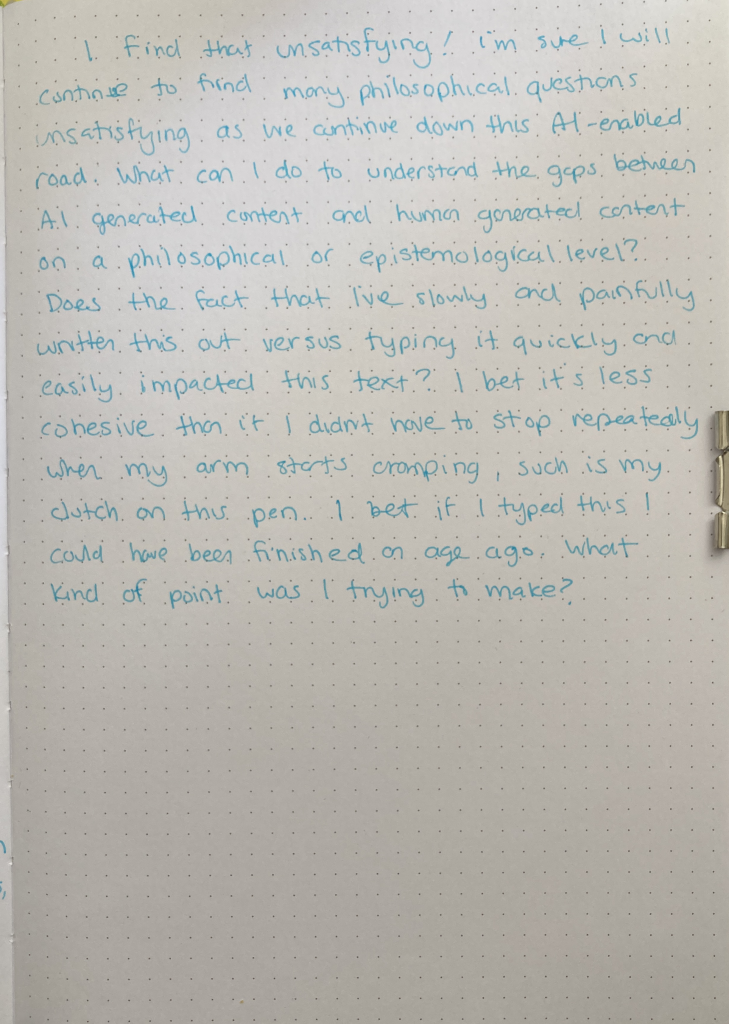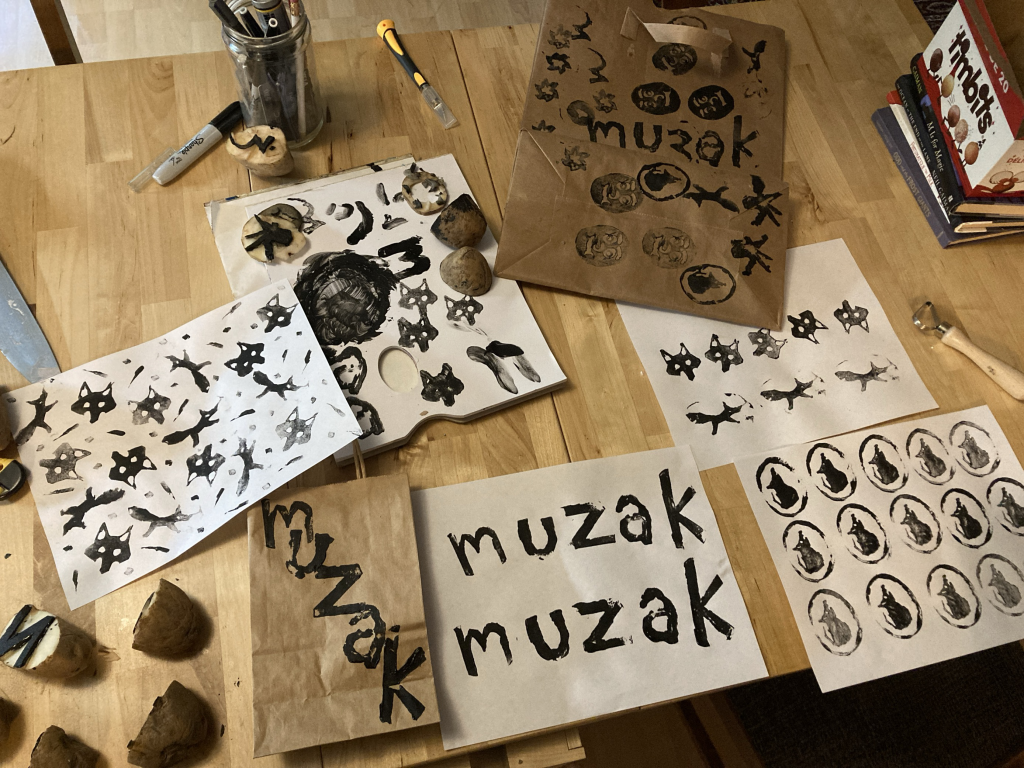Images of Hand Writing



Reflection
I elected to write by hand for this text, because I knew I’d be typing this reflection and wanted to print, write, and type in my response to this task. I found this surprisingly difficult! 500 words is a really achievable amount for me to type so I went in very overconfident but found hand-writing and maintaining a train of thought challenging across that length.
While writing I mused about the procedural differences between typing and writing. Typing lends itself to the scattered, iterative, looping writing process that I’ve developed. When I hand write it’s typically either in personal letters or my weekly planner so my editing process is more focused on adding stickers and washi tape and less focused on grammatical changes or editing for brevity and tone. I believe the choice to write really impacted how I approached the task – I felt much more pressure to have a clear idea of the final product as I worked.
An interesting side effect of writing letters that contributed to my writing process is that now I tend to outline a letter in a journal before writing it. This came about because I would send a letter and have no idea what I wrote in it – with no access to a sent folder I couldn’t remember what I had shared already! I think that dovetails with the ideas explored in both “Stuff to blow your mind” episodes around the impact of writing on the sharing or duplication of information and record keeping (Lamb & McCormick, 2020 May 26).
While my preference is informed by situation and contextually I do enjoy hand writing, it would be dishonest to ignore the idea that >90% of my writing takes the form of typing. My process, and my output, have been deeply impacted by the flexibility that typing and word processing software brings to writing tasks.
Thinking about formats for consuming information like they discuss in the second part of the invention of the book series – I don’t know that I could read a full book made from potato stamped letters, haha, but I do experience text in a variety of ways! For fun reading I typically reach for either a paper book or my Kobo, but for work I lean towards the laptop. The hosts of “Stuff to blow your mind” talk about reading books on their phones which I find mind blowing. I appreciate the opportunity take the time to consider more deeply how the format of text effects not just creation but consumption of text.
Potato Print


Reflection
I enjoyed the potato stamp process! I don’t have children but I do have a weekly Art Night where my friends gather to work on creative projects of all kinds and this was right over the plate for us. You can see the second image in the gallery shows the work my friends created. Because I integrated this into Art Night the process took about an hour for me with lots of chatting and iterative testing of the stamps as we worked. It was interesting to note that one friend arrived organically to the idea of multi color printing “if only I could do a mid tone” – you can through a second stamp! He was not invested enough to pursue a second stamp after his first one, but that was an interesting process to arrive at.
I selected the word “muzak” to print. I had attended a panel that day around generative AI use principles and guidelines at UBC and I found it interesting they lingered over the idea of “original thought”. I wrote on that in my handwriting a little bit, but I find the discussion around original thought quite interesting. In print-making particular – what is original when dealing with a series of reproductions? In thought – what is remix, what is constitutes originality? It smacks of goalpost moving, for me, the idea that there’s an inherent nugget of originality that only human intelligence can achieve… So why “muzak” instead of “music”? I was framing the elevator, easy listening, light, consumable approach of “muzak” compared to “music” as a parallel of generated text versus human written text. I think the space originality is interesting to explore as we are asking more foundational questions about the use of AI.
One aspect of the letters selected in my word “muzak” is that I do write z differently but couldn’t make the stamp work – something about the curve in my hand-writing of z was hard to capture and it wound up looking like a backwards 3 each time! Ultimately I chose to abandon my hand-writing approach and move to a different rendering of z for readability.
Generated Transcription of Hand Written Text
For fun, I thought I’d upload the images of my handwriting to try and automatically generate a transcript or image description of my written work. This was generated with Claude on June 6, 2024 and I have not edited it for accuracy as I’m interested in how the generated writing differs from the hand written text. Honestly, there are not that many mistakes considering the contrast of the pen I selected and my chicken-scratch!
4.4 Task 4: Manual Scripts
Overall, this task contrasts manual and mechanized forms of writing. I wonder about more fringe spaces like the use of AI-supported tools for writing such as Grammarly. Typing versus writing are different ways to approach text development and it impacts the final product in ways from start to finish. What about the layers of additional tweaks? I always get off-ice- suggestions to support brevity and conciseness in my writing, but when hand-writing I’m not getting those direct suggestions. As an exercise, I think I’ll go back and edit this – but when I’m writing letters or in my weekly planner, I don’t actively participate in that editing process in the same way as when I write for work or school using a computer… Circling back to AI – only after the AI course last term have I done really any editing using ChatGPT – overall I still haven’t incorporated it into my own workflows but I know many others have. From my perspective, it’s interesting to consider text as both output and input in these platforms, which is a real departure to how I naturally or currently consider handwritten text. I also typically approach writing in process differently in computer- or mechanized writing –
Image 2: For example I typically start with a structure and I write within that structure. As part of editing, I will move paragraphs around, to experiment with the flow. To contrast, when I am hand writing I feel more pressure to not require that level of foundational editing, as it would be more labour intensive.
This idea of labour is an interesting one to explore especially in this AI-impacted context. I’m in currently AI-operated writing can extend my mechanized writing approach with prompting. I could generate an outline and structure, then generate text, revise, restructure and re order it. How different is that from my mechanized writing which so easily enables me to make those edits and revisions? I’ve asked a few LLMs about human versus AI generated content and originality, and have found pretty unremarkable answers. Claude, which launched today in Canada, indicates that only human original creativity is created on a foundation of understanding of concept when compared to generating text based on probabilities, predictions.
Image 3: I find that unsatisfying / I’m sure I will continue to find many philosophical questions unsatisfying, as we continue down this AI-enabled road. What can I do to understand the gaps between A.I generated content and human generated content on a philosophical or epistemological level? Does the fact that I’ve slowly and painfully writtn this out versus typing it quickly and easily impacted this text? I bet it’s less cohesive than if I didn’t have to stop repeatedly when my arm starts cramping, such as my clutch on this pen. I bet if I typed this I could have been finished an age ago. What kind of point was I trying to make?
References
Lamb, R., & McCormick, J. (Hosts). (2020, May 26). From the vault: Invention of the book, part 1. [Audio podcast episode]. In Stuff to blow your mind. iHeart Radio.
Lamb, R., & McCormick, J. (Hosts). (2020, May 28). From the vault: Invention of the book, part 2. [Audio podcast episode]. In Stuff to blow your mind. iHeart Radio.
Hi Brie
To your point, ‘An interesting side effect of writing letters that contributed to my writing process is that now I tend to outline a letter in a journal before writing it. This came about because I would send a letter and have no idea what I wrote in it – with no access to a sent folder I couldn’t remember what I had shared already!’ When I outline a letter before writing it, I ensure that my thoughts are organized and that I cover all the points I want to address. This helps me maintain the flow of the conversation and makes sure I don’t miss responding to any important parts of the previous letter. This practice has improved the quality of my writing in general, as it encourages me to think critically about structure and content.
I believe that in letter writing, the etiquette involves responding to the content of the previous letter. This means I don’t have to remember every detail of what I wrote, as the response should naturally reference and engage with my points. This reciprocal dialogue not only enriches the exchange but also helps me maintain a coherent thread of conversation. The person receiving the letter acknowledges my story, adds their own narrative, and poses questions, creating a meaningful and engaging correspondence.
I can’t even remember the last time I actual wrote a hand written letter to anyone. A birthday card, a thank-you note…yes, but full fledged letter – my memory fails me.
How about you? When did you last engage in hand written correspondence? Did you initiate? Or did you respond? How much back and forth correspondence was there?
Hi Carol!
I write letters back and forth with my Aunt – typically about one every month or two. We both are fans of stationery and she has an amazing collection of inks and fountain pens. I feel very lucky to have this relationship.
I think the periodicity of the letter writing process also affects the strategies I use to respond – we respond to what is in the contents of the letter of course, but sometimes it’s difficult to remember what news I have shared or not yet shared if it hasn’t been addressed in the most recent letter. Have I mentioned the community garden plot or not? Did I tell her the types of tomatoes I’ve planted? How much have I complained about work recently, should I back off on that topic?? (Kidding!)
I agree with the outline – also crucial when it comes to hand-writing instead of computer-writing. Excellent to have a map of where you are going when you set out on a journey 🙂